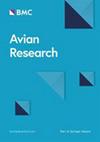雄性羽毛的快速进化驱动了飞蛾的性别二色性
IF 1.7
2区 生物学
Q1 ORNITHOLOGY
引用次数: 0
摘要
性别二色性是鸟类两性表型分化的一种主要形式,其进化可能是由性选择和自然选择之间的相互作用形成的。Ficedula属广泛分布于欧亚大陆,在性别二色性和迁徙行为上表现出明显的种间差异,使其成为研究鸟类性别二色性进化模式和驱动因素的理想研究系统。在本研究中,我们对32个Ficedula物种的羽毛复杂性和性别二色性进行了系统发育比较分析。我们进一步探讨了生活史特征如何影响性别二色性的进化。我们的研究结果表明,雄性羽毛复杂性与性别二色性程度呈正相关,雄性羽毛复杂性的进化速度明显快于雌性。迁徙物种表现出明显更高水平的二色性。此外,与单色物种相比,两性二色物种具有更高的纬度分布、更广泛的地理分布和更大的飞行能力。这些发现表明,在系统发育约束下,性选择和自然选择共同推动了飞禽性别二色性的进化,促进了我们对鸟类性别二色性进化驱动因素的理解。本文章由计算机程序翻译,如有差异,请以英文原文为准。
Rapid male plumage evolution drives sexual dichromatism in Ficedula flycatchers
Sexual dichromatism represents a major form of phenotypic differentiation between the sexes in birds, and its evolution is likely shaped by the interplay between sexual and natural selection. The genus Ficedula, widely distributed across Eurasia, exhibits pronounced interspecific variation in both sexual dichromatism and migratory behavior, making it an ideal study system for investigating the evolutionary patterns and drivers of avian sexual dichromatism. In this study, we conducted a phylogenetic comparative analysis of plumage complexity and sexual dichromatism across 32 Ficedula species. We further explored how life-history traits influence the evolution of sexual dichromatism. Our results reveal a strong positive correlation between male plumage complexity and the degree of sexual dichromatism, with males evolving plumage complexity at significantly faster rates than females. Migratory species exhibit significantly higher levels of dichromatism. Furthermore, compared to monochromatic species, sexually dichromatic species are characterized by higher latitudinal occurrence, broader geographic distributions, and greater flight capacity. These findings demonstrated how sexual and natural selection jointly drive evolution of sexual dichromatism in Ficedula within phylogenetic constraints, advancing our understanding of the evolutionary drivers of avian sexual dichromatism.
求助全文
通过发布文献求助,成功后即可免费获取论文全文。
去求助
来源期刊

Avian Research
ORNITHOLOGY-
CiteScore
2.90
自引率
16.70%
发文量
456
审稿时长
46 days
期刊介绍:
Avian Research is an open access, peer-reviewed journal publishing high quality research and review articles on all aspects of ornithology from all over the world. It aims to report the latest and most significant progress in ornithology and to encourage exchange of ideas among international ornithologists. As an open access journal, Avian Research provides a unique opportunity to publish high quality contents that will be internationally accessible to any reader at no cost.
 求助内容:
求助内容: 应助结果提醒方式:
应助结果提醒方式:


